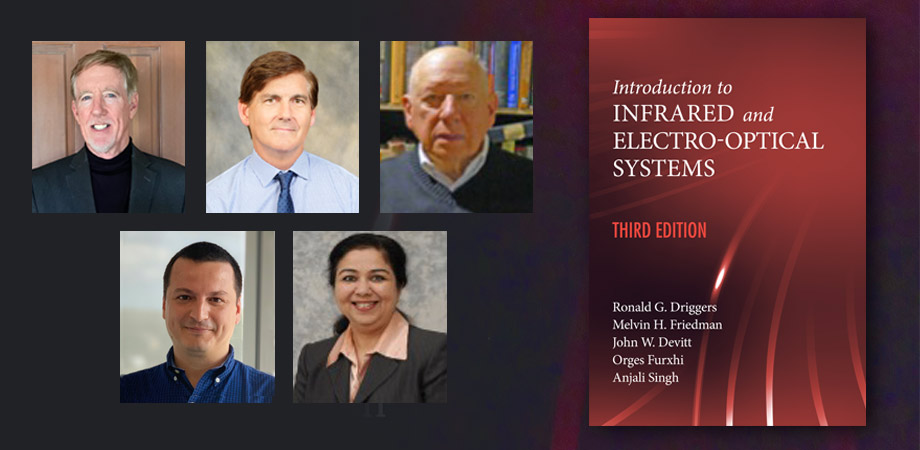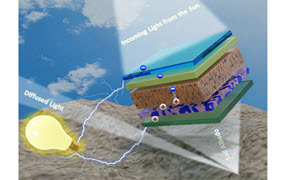Driggers, Friedman, Devitt, Furxhi, Singh are recipients of the 2024 Joseph W. Goodman Book Writing Award for Introduction to Infrared and Electro-Optical Systems, Third Edition

BELLINGHAM, Washington, USA — SPIE and Optica have announced Ronald G. Driggers, Melvin H. Friedman, John W. Devitt, Orges Furxhi, and Anjali Singh as the 2024 recipients of the Joseph W. Goodman Book Writing Award for their Introduction to Infrared and Electro-Optical Systems, Third Edition.
The book, published in 2022 by Artech House, was chosen for its comprehensive coverage of system-level electro-optics, as well as the authors’ ability to explain the fundamental principles of infrared and electro-optical systems, providing a strong mathematical foundation and making it an invaluable resource for educational purposes. An associated website (photonicsproject.org), supplements the book with visual and interactive tools to reinforce the concepts and equations discussed in the text.
This edition features new chapters that explore areas previously lacking in detailed textbook coverage including modeling and simulation of both pilotage and infrared search and track applications, as well as the Simplified Target Acquisition Model. These additions, along with substantial updates to sections on detectors – particularly photon-based detectors – and image-processing methods, enhance the book's relevance and value to the scientific and engineering communities. The original edition was published in 1999.
“Introduction to Infrared and Electro-Optical Systems is a well-conceived, polished, and highly informative book,” notes 2024 Goodman Book Writing Award Selection Committee Chair Matt Jungwirth. “The text contains a comprehensive treatment of the analysis and design of electro-optical imaging systems. The committee was especially attracted to the impact this text may have on the community due to its broad appeal and widespread topics.”
Ronald G. Driggers is a professor at the University of Arizona’s Wyant College of Optical Sciences and works in the areas of electro-optical and infrared imaging systems. Previously, he was appointed to the Senior Executive Service as the superintendent of the Optical Sciences Division at the Naval Research Laboratory, managing the efforts of more than 200 scientists and engineers and over $100 million in research and development programs. Driggers is the author of five books on infrared and electro-optics systems and was editor-in-chief of the Encyclopedia of Optical Engineering. A Fellow of SPIE and Optica, Driggers was the editor-in-chief of SPIE’s Optical Engineering from 2010 to 2015, and the editor-in-chief of Optica’s Applied Optics from 2015 to 2021.
Melvin H. Friedman, retired after 48 years of government service, is an affiliate faculty member of George Mason University working on traffic-light coordination. He is the primary inventor of eight patents; helped develop the first digital imaging radiometer that worked simultaneously in the 3 to 5 and 8 to 12-micron bands; and was the optics editor for the Encyclopedia of Optical Engineering. Friedman has a wide range of experience across nuclear physics (beta ray spectrometry, nuclear scattering, application of neutron activation analysis to food and drug safety), automation (neutron activation data collection and reduction), microscopy (scanning electron, electron probe microanalysis), land-mine detection (using scattered electromagnetic waves), electro-optics (development of intelligence gathering instruments), and modeling (electro-optical and search).
John W. Devitt is a principal fellow and chief engineer for RVS Tactical Products. His current and previous responsibilities have spanned some of the largest and most significant infrared detector programs, including EODAS, 3GEN FLIR, and OPIR. He holds more than 20 patents and was a primary contributor to the Photonics Project website (https://photonicsproject.org/). Devitt was appointed to the National Academy of Sciences in 2014. He was recognized as a Military Sensing Symposium Fellow in 2016, and as a Principal Fellow at Raytheon in 2017.
Orges Furxhi is a principal member of the technical staff at imec. His professional interests focus on passive and active imaging systems and their applications. Before joining imec, he was the director of engineering at St. Johns Optical Systems where he was responsible for camera product development. As a postdoctoral fellow at Duke University and the University of Memphis, he developed several infrared, millimeter-wave, and terahertz imaging systems.
Anjali Singh was most recently vice president of payload at Planet Labs. Previously, she was an engineering fellow/chief engineer at Raytheon for Advanced Tactical Programs, and, at Northrop Grumman, she held several lead positions including an IPT lead on a major space program. She also served as the architect/SEIT lead of the Space Inertial Product Line at the Navigation Systems Division, and, on the Airborne Laser Program, as the optics and controls products system engineering lead. Her other experiences include roles at Inphi Corporation, where she built an optical system testbed for 10-Gbps and 40-Gbps optical communication system components, and at JDS Uniphase, where she developed EDFA and Raman amplifiers for long-haul communications systems.
The Joseph W. Goodman Book Writing Award, a biennial award co-sponsored by SPIE and Optica, recognizes authorship of an outstanding book in the field of optics and photonics, published within the last six years, that has contributed significantly to research, teaching, or industry. It was established in 2005 and is funded by Joseph and Hon Mai Goodman.
About SPIE
SPIE, the international society for optics and photonics, brings engineers, scientists, students, and business professionals together to advance light-based science and technology. The Society, founded in 1955, connects and engages with our global constituency through industry-leading conferences and exhibitions; publications of conference proceedings, books, and journals in the SPIE Digital Library; and career-building opportunities. Over the past five years, SPIE has contributed more than $24 million to the international optics community through our advocacy and support, including scholarships, educational resources, travel grants, endowed gifts, and public-policy development. www.spie.org.
About Optica
Optica, Advancing Optics and Photonics Worldwide, is the society dedicated to promoting the generation, application, archiving and dissemination of knowledge in the field. Founded in 1916, it is the leading organization for scientists, engineers, business professionals, students, and others interested in the science of light. Optica’s renowned publications, meetings, online resources and in-person activities fuel discoveries, shape real-life applications and accelerate scientific, technical and educational achievement. Discover more at: Optica.org
Media contacts:
Optica:
Leah Poffenberger
Corporate Communications Manager
lpoffenberger@optica.org
+1 202 416 1994
@OpticaWorldwide
SPIE:
Daneet Steffens
Public Relations Manager
daneets@spie.org
+1 360 685 5478
@SPIEtweets



